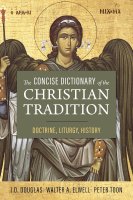Zondervan has re-released a 1989 hardback publication as a paperback which some readers may find a useful tool, especially those who do not have both ready access to internet resources and a mature acumen to sort through the deluge of available pieces on the internet. Boasting of more than 3000 entries, this resource provides short definitions of historical, ecclesiastical, and doctrinal terms from a wide variety of Christian traditions, both orthodox and heterodox. The three well known, distinguished authors of this volume are theologians, pastors, and writers or editors of evangelical books.
At first glance, some readers may find the short definitions too concise and perhaps not the most useful. Upon closer examination of each entry, however, an asterisk is found next to terms within each concise definition. These asterisks apprise that the marked terms also are an entry in this dictionary. By following these terms through the book, the reader gets a more complete picture of the definition provided. Since each definition has at least one asterisked term to consult, the reader gets a nested picture of the information sought by chaining together a series of terms. For example, under Leo X, the Florentine de Medici pope who excommunicated Martin Luther, one finds asterisks guiding the reader to cardinal, Renaissance, indulgences, Luther, and Reformation. And each of those have asterisked terms in their entries for further investigation. One only could wish that this helpful marking had been explained somewhere within material appended to the front of the book rather than left to chance discovery by the reader. Additionally, some could wish for an electronic text in which these asterisks are live links.
Up through its initial release in 1989, the book provides a somewhat comprehensive listing of entries whether one looks for theological streams and heresies from the early Church era, to many significant figures of Western churches and Western movements, to basic ideas and terms associated with both free and institutional churches. What is not covered, however, are ideas, movements, and historical figures in the intervening near thirty-five years and more. Accordingly, not covered, for example, are important ideas, events, and people such as the New Perspective on Paul propounded since 1977; the eschatological crises among a number of churches at the turn of the twenty-first century which expected the end of the world had come; and significant figures such as South Africa's Archbishop Desmond Tutu or Bartholomew I, Ecumenical Patriarch of Constantinople since 1991. Additionally, for example, no notice is given to the history and leaders of the Nestorian Church (Church of the East) even though it was once the largest Christian church by geographical expanse and perhaps in numbers of adherents. Neither is any mention made of the African Indigenous Church movement nor the leaders and explosive growth of the Neo Pentecostal denominations of South America.
The concept of a concise, one volume dictionary of Christian traditions written by knowledgeable authors is praiseworthy. Hopefully Zondervan will take this good concept and release an updated, revised edition. Until then, given the datedness of the information this volume contains as to completeness, given the decidedly Western and non-majority world perspective for the selection of entries, and given that hundreds of copies of the original book with the exact same content from 1989 are available on the used market for a fraction of the cost of this new release, this paperback edition is not a recommended purchase for most of the readers of this journal, especially those living in or primarily working with topics related to Christianity in the majority world.
